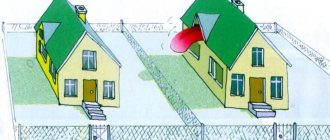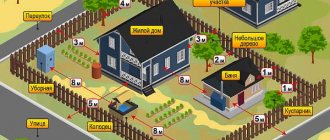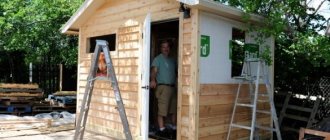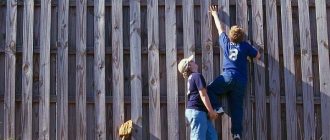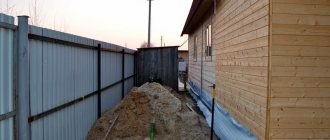The distance from the house to the neighbor’s fence is one of the necessary parameters that should definitely be taken into account when planning your new building site. A plan drawn up in accordance with building codes and regulations (SNiP) is necessary in order to arrange your land ownership as convenient and comfortable as possible. The main thing is that the law is not violated and no grounds are given for complaints from disgruntled neighbors or simply ill-wishers.
Suburban area
It is important that local authorities (whether it is the management in SNT or the local administration during the construction of individual housing construction) approve this plan. Distance standards during construction must also be observed for fire and sanitary safety.
Building codes in fencing planning
When installing a fence separating a plot of land from a street or neighboring property, you cannot be guided solely by your wishes. It is possible to build a fence between neighboring areas only in accordance with certain requirements. The same applies to the distance between residential buildings. In order to avoid errors in the location of buildings, they carry out a geodetic reference of the boundaries of the site and the location of buildings from the cadastral extract and design documentation.
There are a number of documents that standardize what distance should be to fences and fences. The main one is SNiP No. 441, developed in 1972. The document indicates the maximum permissible height of the fence between the territories of neighbors - 1.5 m and the external fence - 2.2 m. But the local administrative authority can make its own adjustments regarding this value. This is due to architectural or other requirements for a particular location.
Therefore, before constructing fences for the territory, it is necessary to find out the parameters of the permissible height, first of all, from the local municipal authorities.
Requirements for the appearance and height of the fence can be put forward by the administration of the settlement Source eracaperealty.com
Fire safety standards regulate the installation of a fence from a safety point of view in the event of an open fire. With crowded buildings in close proximity to large trees, a fire can spread very quickly.
Sanitary recommendations are intended to avoid air, soil and water pollution and the spread of unpleasant odors. This is very important when constructing cesspools, building sheds for keeping small livestock and poultry, and enclosures for dogs on the site. SNiP specifies the minimum distance from the house to the neighbor’s fence. The distance is measured from the base of the structure or its protruding part if its size exceeds 50 cm.
If you violate construction standards that determine the distance between residential and non-residential buildings on the territories of neighboring plots, this can cause serious consequences: misunderstandings with neighbors, litigation, problems with the law.
Therefore, you need to carefully read the construction standards for a summer cottage, prescribed in SNiP, in order to apply them when developing the territory.
Judicial practice with examples
The practice on these disputes cannot be called unambiguous. Some lawsuits were doomed to fail.
Thus, the plaintiff asked to demolish the fence, the height of which was not 1.5, but 2 m. The court took into account the expenses incurred by the defendant for the construction of the fence and the lack of evidence that it would obscure the neighbor’s property. The cassation court made concessions to the plaintiff on the same issue and decided to reduce the fence by 50 cm.
Violation of building standards will entail penalties and the obligation to eliminate inconsistencies. If you want to prove that your neighbors are violating your rights, you should conduct photo and video recording. Such evidence will be taken into account by the court and will help get rid of improperly managed wastewater or excess rainwater. A forensic environmental examination or witness testimony will also come to the rescue.
Negative claims have no statute of limitations. You can go to court at any time from the moment of violation of rights.
Allowable distance between neighbors' houses
If a plot of land for individual housing construction is purchased in the private sector, where neighbors already live, when laying a house, you should take into account the existing buildings.
Fire resistance categories of buildings Source build.4-u.info
According to the requirements of SNiP, the distance from the building to the boundary of the site depends on the material of the building:
- The largest setback should be from an existing wooden building: 15 m when building a new house made of wood and 10 m - from stone, brick and concrete.
- If both houses are made of brick or concrete, but have wooden floors, the distance between such residential buildings should not be less than 8 m.
- Buildings made of non-combustible materials without wooden elements can be located closest - this is a distance of 6 m.
- If houses have 2–3 floors, the safe distance between them according to SNiP is more than 15 m.
The position of objects on the territory of a private plot is not strictly regulated by fire safety standards.
The minimum permissible distance between neighboring houses is 6 m Source build.4-u.info
See also: Catalog of construction companies that offer house design services.
Standardization of construction
When designing and constructing all kinds of objects, Russian legislation requires compliance with certain building codes and regulations. Many of them were developed back in the Soviet period, but are still in effect today, as they do not lose their relevance. Just as there are GOST standards for goods, corresponding construction standards are provided for low- and high-rise residential buildings, as well as utilities. For example, SP 30-102-99 regulates the planning and development of the private sector.
Distances from outbuildings to the fence
Construction standards regulate the location of outbuildings on the site relative to the fence:
- If it is planned to build a shed for storing gardening tools or a garage on the territory, the minimum distance from the fence should be 1 m. The slope of the roof slope must be directed to your site.
- If small animals are to be raised in the barn, the distance from the boundaries of the site will be at least 4 m. Greenhouses using organic fertilizer are placed at the same distance from the fence.
- For structures with an increased fire hazard where open fire is used, it is not recommended to bring the structure closer to the fence than 5 m. This list includes baths, boiler rooms, and solid fuel saunas.
- The distance from the garage to the fence is at least a meter. But only if the remaining buildings are 6 m away from the fence.
The rules for the location of buildings on a plot of land and the distances between them should not be ignored, not only to avoid problems with the law, but also for the purpose of convenient and safe operation of these buildings.
Permitted distances from buildings to the fence, established by sanitary, household and fire safety standards Source garshinka.ru
- Showers and toilets are allowed to be located on the site no closer than 2.5 m from the fence. Baths and saunas using gas fuel and electricity can be built at the same distance.
- Spreading tall trees should not be located closer than 3 m from the fence. The distance is determined from the center of the trunk to the edge of the area. If this condition is met, the shadow from the crown will not disturb the neighbors.
- Medium-sized trees can be planted no closer than 2 m, and shrubs - 1 m from the boundaries of the territory.
Building codes indicate the minimum permissible distance between buildings, plantings and fences Source zen.yandex.ru
What is SNiP?
Information!
SNiP is a document developed based on many years of experience in the construction industry. The norms are advisory in nature, but on their basis federal and regional legislative acts have been developed, compliance with which is mandatory for all citizens of the Russian Federation.
For all regions of Russia, the provisions of SNiP may be different. The standards take into account the climatic and relief features of the subjects. The rules listed in the document allow buildings to be comfortably located on the site and reduce fire and epidemiological danger in the area. Additional rules may be established by dacha and gardening non-profit partnerships.
The height of the fence in front of the neighbor's windows
The fence between plots should not cause inconvenience to neighbors living nearby. Height requirements largely depend on the type of fencing.
The fence cannot have a height greater than 1.5 m if its structure is lattice or mesh.
A mesh fence can have a maximum permissible height for fencing - 1.5 m Source dub.by
The height of blind fences should not be more than 0.70 m. If this size exceeds the recommended value, you should obtain written permission from your neighbors. If a conflict arises, it may be needed.
It is allowed to build up a blind fence with a height of 0.70 m using any translucent materials up to a maximum value of 1.5 m without approval from neighbors.
Reference! In some regions, construction standards on a summer cottage allow the area to be enclosed with a transparent fence up to 2.2 m, and a solid fence up to 0.75–1.5 m.
A blind fence can be built up with mesh, lattice, or wooden sheathing with gaps. Source build.4-u.info
When installing a fence over 5 cm thick, it should be located on the territory of a summer cottage. If it is necessary to install a thick structure on the boundary, written consent of the neighbors is required.
If a fence installed on a site causes flooding of a neighboring household with melt and rain water, it is necessary to make a drainage system, otherwise the design of the fence will need to be changed or will have to be removed completely.
From the point of view of norms and rules, the installation of a lattice, mesh fence or hedge of ornamental and fruit bushes around the territory will not cause any complaints.
Board fences must have clearances of 50% of the total area.
Important! Materials and structures for fencing the territory of a summer cottage must be safe, securely fastened and not have sharp protruding parts.
A permanent fence around the territory can be erected only after the boundaries of the site have been registered with the cadastral bureau. Before this, you need to use temporary fencing, for example, from a chain-link mesh.
Conflict resolution through court
If it is impossible to resolve the conflict peacefully, you will have to resort to going to court. If the claim amount is up to 50 tr. The application should be submitted to the magistrate. When you receive a subpoena from the court, you must prepare for the hearing.
You should once again monitor your territory and try to eliminate the most obvious violations in the permissible distance between buildings. You must talk about your actions aimed at correcting non-compliance with standards at the meeting.
The court will definitely take into account such efforts, and it will probably be possible to cancel the demolition of the building. If, nevertheless, a decision was made not in favor of the defendant, it can still be appealed. Such actions, if they do not cancel the first decision altogether, will at least provide a delay for its execution.
If neighbors take actions aimed at causing inconvenience during litigation, then they can be challenged through a negative action. It should reflect the infringement of the rights to use the site.
The claim must contain the problem itself, the name of the disputed object and its address, as well as the diagram according to which the buildings are located. If, as a result of the actions of neighbors, crops were lost or noise levels were exceeded, you can demand compensation for the damage caused. When applying, you should also provide title documents for the site. This way the court will establish the legality of requests for protection of interests.
How to arrange buildings inside the site
Before construction begins, it is necessary to draw up a site plan with the location of the residential building and outbuildings (for this, a topographic survey of the site is performed). The basic law regulating the construction of facilities on the site, SNiP 30-02-97. Here are recommendations aimed at ensuring the safety and health of people. Construction standards indicate at what distance objects can be built inside a summer cottage:
- A toilet with a cesspool, a barn for poultry and small livestock should be located no closer than 12 m from a residential building and cellar.
- A septic tank, toilet, and compost heap are installed at a distance of more than 8 m from the well.
- Shower, bath, sauna - at least 8 m between them and residential buildings and cellars.
Permissible distance between buildings within the site Source o-nedvizhke.ru
Distance from road to house
When building houses, the term “red line” is used. It marks the boundary between the territory of a private plot and a street or driveway.
If the fence is located directly on the “red line”, the gate leaves and wicket should open inward. The conditional line must not be cluttered or built upon under any circumstances, because the passage of cars and the passage of pedestrians is disrupted.
SNiP 30-02-97 determines the distance from the “red line” to:
- residential building – 5 m;
- outbuildings – 5 m.
In cases where the site is not bordered by a street (with a name), but by a passage (alley without a name), these indents are equal to:
- to housing – 3 m,
- to outbuildings – 5 m.
The distance from the building to the boundary of the site - the “red line” depends on the type of street Source promstall.ru
These values are mandatory and not advisory. In case of violation of this clause, local authorities may require the dismantling of the fence and even the building. In addition, the minimum distance from the fence to the road will depend on the laid communications.
At what distance from the fence can you build a house on a garden plot?
According to the norms of individual housing construction, the distance from the fence to the residential building cannot be less than 3 m. It is not worth moving the building closer to the edge of the territory, not only because of strict rules, but also common sense. In addition to protection from street noise and prying glances, such a gap will make it possible to carry out maintenance and external repairs of the building.
Even if there is an agreement with the owner of a neighboring summer cottage that he is satisfied with the closer proximity, you should not violate this point. Failure to comply with the minimum distance to the fence when building a house is often the cause of civil strife, which can lead to litigation in court. Nerves and money will be wasted, and the court will make a decision not in favor of the person who violated the law.
Failure to comply with these construction standards on a summer cottage will result in large administrative fines or even forced dismantling of the structure.
Disputes with neighbors over improper location of buildings or fences often end in litigation Source stargate-rasa.info
When planning the construction of a house, you need to take into account the requirements for its location. The distances from the site boundary to the building are determined as follows:
- Step back from the “red line” 5 m if there is a street behind the fence, or 3 m if there is a passage there.
- There should be a fire safety separation distance from the neighbor's house. Depending on the flammability of the materials of the building being constructed and the existing building, a minimum value is selected, which can range from 6 to 15 m.
- At the same time, the condition must be met - the distance between the house and the fence is at least 3 m.
When combining a residential building with a garage or outbuildings, the distances to the fence are taken to be 3 m.
The remaining household objects are located from the house no closer than the minimum permissible distances in compliance with restrictive standards in relation to the neighboring plot and house.
The location of buildings, fences, and plantings on garden and dacha plots is subject to building codes Source proprietor.ru
Responsibility for violation of construction rules
Compliance with building standards is also supported by administrative legislation. This means that if violations are detected, the owners of such buildings can expect a fine of about 2 thousand rubles. The signal to action for officials of the local architectural department or prosecutor's office will be a complaint from neighbors. At the first inspection, violations of permissible distances on the site will be identified, and, consequently, a fine will be issued.
It should be remembered that only a court can force the demolition of a building that violates the norms. Typically, neighbors may complain about a lack of light or excessive noise. The Civil Code of the Russian Federation also confirms the obligation of all neighbors not to obstruct each other from using their own property.
Before going to court, you should compare the upcoming expenses for state fees and examinations and the effect obtained during the process. Sometimes reaching an amicable agreement with your neighbors is much cheaper.
